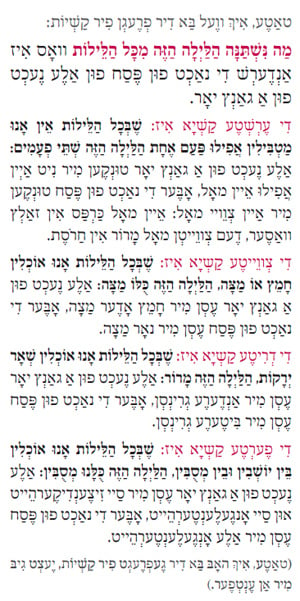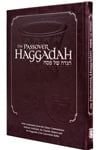different commentary on 4 questions
Focus on Questions
Questions are essential to the Seder. They must therefore be asked even when no child is present.
For example, even at a Seder attended only by two Torah scholars proficient in the laws of Passover, one scholar must ask the other. One who is alone asks the questions to himself. (Talmud, Pesachim 116a)
What is the point of asking oneself the questions? The mitzvah tonight is to tell the story to another person. By asking yourself the questions, you become the “other” to whom you will relate the story. Role-playing in this manner helps a person absorb the information with greater clarity and profundity. (The Rebbe)1
Questions Repeated
Once the children have asked the questions, the leader does not have to repeat them. (Maharil; Shulchan Aruch HaRav)
Nevertheless, the rebbes of Chabad, after hearing the children and grandchildren ask the questions, would then recite the questions themselves in an undertone.
This custom coincides with the opinion of Rambam, who maintains that the Seder leader recites the four questions. It is now the universal Chabad practice for everyone to recite the four questions after the children ask the questions. (The Rebbe)2
After a Father’s Passing
It was the custom of the Chabad rebbes to preface their recitation of the four questions with the words, “Father, I will ask you the Four Questions.” They did so even long after the passing of their fathers,3 and this is now the standard Chabad custom.4

Moses said to Joshua: “This nation that I am entrusting you with, they are still young goats, they are still children. Do not be irritated with them for what they do, for their Master too was not irritated with them for what they did.” As it is written, “When Israel was a youth, I loved him; from Egypt I summoned My son.”
When Israel rebelled against G‑d at the Sea of Reeds, the angels said to G‑d: “They are rebelling and provoking, yet You are silent?!”
G‑d said to the angels: “They are children. And one does not get irritated with children. Just as a child emerges soiled from the womb and is then washed, so too Israel: ‘I washed your blood from upon you. I anointed you with oil and dressed you in embroidered garments . . .’” (Ezekiel 16:9–10)
—Yalkut Shimoni5
Like the Love for a Child
It was handed down in the name of the Baal Shem Tov that there are two versions to the introduction to the Four Questions:
- “Father, I want to ask of you four questions”;
- “Father, I will ask of you four questions.”
Each version, however, begins in an identical manner—“Father.” This refers to our Father in Heaven, to whom all of Israel ask the Four Questions. (Rabbi Yosef Yitzchak of Lubavitch)
The child’s asking stimulates G‑d’s love for us, like the love of parents for their young child, as in the verse (Hosea 11:1) regarding the time of the Exodus: “For Israel is a youth, [therefore] I love him . . .”
The Torah in several instances describes us as being G‑d’s children. The above verse, however, emphasizes that G‑d’s love for us is like a parent’s love for a young child.
Parents love their children because the parent and child are of one essence. But this love is most felt for young children. As children mature, the parents begin to love them for their accomplishments and qualities as well, for their wisdom, good character, or the honor and care they show to their parents. This latter love obscures to some extent the innate, unconditional parental love.
The love for a young child, by contrast, who is not yet wise, or good, or helpful, is pure parental love, the unconditional love of two beings that are of one essence. The love for the young child is therefore stronger and more evident, since it is not obscured by a conditional love.
Similarly, when we speak of G‑d’s love for us in the way a parent loves a young child, we refer to this essential, unconditional love born of our inherent bond with G‑d.
Staying Young
When we become “mature” and self-aware because of our wisdom and accomplishments, we obscure our essential oneness with G‑d with our sense of self and separateness. But when we humble ourselves like a small child before G‑d, when we see our wisdom and accomplishments as an extension of our service of G‑d, the oneness is restored: we rediscover our youth and the special divine attention that comes with it. (The Rebbe)

Four Cups
We do not ask about the Four Cups, because drinking them is not a biblical requirement, nor does it involve any biblical requirement—it is entirely rabbinic in origin. Reclining and dipping, by contrast, although not biblical requirements per se, are connected to biblical requirements: reclining is done while fulfilling the biblical mitzvah of matzah; and dipping, at least the second one, involves the bitter herbs, likewise a biblical mitzvah in Templetimes. (Maharal)

On this night we dip twice. Although we also dip the bitter herbs in charoset paste when eating the korech “sandwich,” we do not consider this a separate dipping from the bitter herbs dipping, since korech is performed only out of doubt as to how bitter herbs should be eaten. (Taz)6
On this night, bitter herbs. We do not say “on this night, only bitter herbs” as we say of the matzah, since we eat other vegetables during the first dipping. (Tosafot)7
On this night we all recline. This question appears neither in the Mishnah’s version of the questions, nor in that of the Talmud. Some have suggested that it was added at a later time, when people stopped reclining all year round. (The Vilna Gaon)

Development of the Four Questions
We find many different versions of the Four Questions in the various manuscripts of the Talmud—not only in the order of the questions, but in the number as well. Some versions, for example, omit the question about bitter herbs; others omit the question about the Paschal lamb, even in Temple times.
The above would seem to indicate that initially there were various acceptable versions, or perhaps no fixed version at all. This was because, according to Jewish law, one need not ask all the questions.
As the Talmud relates, when Abbaye as a child saw the table being removed from before Rabbah, he exclaimed: “We haven’t eaten yet—and they come and remove the table from before us?!” Rabbah turned to the child and said: “You have exempted us from having to say the four questions.”8
At some point, however, the sages consolidated the various customs and instituted a universal practice of reciting all the questions, so that all of Israel would follow the same custom.
Another example of this sort of development is the way we blow the shofar:
The requirement is to blow a wailing sound, called a teruah, preceded and followed by a simple blast, called a tekiah. According to Rav Hai Gaon,9 for many centuries the definition of the “wailing” teruah remained unfixed, with various communities performing it in their own way. Some Jewish communities performed it as heavy groans. For others, it was very short “cries,” and yet other communities performed it as a combination of both.
In Talmudic times, the sages sought to unify all of Israel with a universal custom. They therefore instituted that all Jews blow the shofar in a manner that included all three customs. (The Rebbe’s Haggadah)

Sitting vs. Reclining

Chassidic teachings differentiate between two levels of loyalty and devotion to G‑d: an imposed devotion and an innate devotion. The first kind is experienced by those who are filled with an awareness of “self,” a feeling of being independent from G‑d and outside of Him. Yet, through study and contemplation, they come to the recognition that it is logical and good to devote themselves to their Creator, who is infinite.
They therefore overcome the “self” and devote themselves to G‑d. But the independent “self” remains intact; it is merely suppressed. (This is called bittul hayesh, and is associated with the lower three worlds, beriah, yetzirah and asiyah.)
A higher level of devotion, usually associated with the saintly, is an existential and innate devotion, one in which there is no “self ” that needs to be overcome. Such a person is not susceptible at all to sin. (This is called bittul b’metziut and is associated with the highest world, atzilut, which is entirely permeated with divine awareness.)
Sitting and reclining are manifestations of these two levels of devotion:
- Sitting: Imposed Devotion (beriah, yetzirah, asiyah).
- Reclining: Innate Devotion (atzilut).
When we sit down, our heads are brought to a lower position. This symbolizes a partial bowing to the divine, since the head is not completely lowered. But when we recline, our heads are nearly if not completely lowered. This symbolizes an absolute and innate “bowing” to the divine.
Tonight we all recline: Tonight, because of the intensity of the divine revelation that occurred on this night, and which reverberates each year, kulanu mesubin, we all recline—we are all imbued with an innate devotion to the divine. This fleeting revelation that overwhelms us on Passover gives us a jolt, a jump-start for the work of refining the “self” during the forty-nine days between Passover and Shavuot. (The Rebbe)10
Customs
Of all the rituals addressed by the child, dipping seems to be least important. Unlike matzah and bitter herbs, it is not a biblical or rabbinic mitzvah; and unlike reclining, it does not express a central theme of the holiday.
How striking, then, that the first of the four questions addresses neither the first ritual the child encounters—reclining while drinking the kiddush wine—nor the more essential rituals of the night, but a custom!
The haggadah thereby addresses a misconception regarding the place of custom in Judaism. Some consider customs to be nonessential, a “luxury.” They recognize the need to make sacrifices for fulfilling G‑d’s commandments, but they would not do the same for “mere” customs. In regards to educating children, they argue, we ought to compromise on the customs so as to better focus on the primary obligations.
The Four Questions tell us otherwise. What is the first thing that the child asks about? What grabs his or her attention and makes the deepest impression? Jewish customs. Not only are they not expendable, they are central. For the customs have the unique capacity to sensitize a child to the sanctity of Torah and G‑d’s commandments.
The customs give our children a strong Jewish identity and the sense that they are part of a nation chosen by G‑d to be beacons of goodness and holiness in this world. (The Rebbe)11
Holy Questions
Questioning is essential to acquiring wisdom. Without critical analysis, one’s wisdom is incomplete. On the other hand, the quality of faith and simplicity precludes questioning, as in the verse (Deut. 18:13), “You shall be wholehearted with G‑d.”
Intellectualization and simplicity are two mutually exclusive traits that cannot possibly coexist. Our sages therefore instituted questions within the realm of holiness. These have the mystical effect of refining the phenomenon of “questions,” enabling us to maintain simplicity even while engaged in intellectual endeavor. (Rabbi Yosef Yitzchak of Lubavitch)12

The Order
This order of the questions—(1) dipping, (2) matzah, (3) bitter herbs, (4) reclining—is the order found in the version of the Mishnah as it appears in the Jerusalem Talmud, Alfasi and Rosh (though the last two questions do not appear there). This is also the order found in the siddurim of Rav Amram Gaon and Rav Saadiah Gaon, Rambam, Tur, Avudraham (by implication, since his commentary addresses the question about dipping before the others), Abarbanel, Pri Etz Chaim, siddur of the Arizal, Mishnat Chasidim, and others. It is also the order found in the first printed haggadah (Soncino, 1485).
It also follows the order of the night, where dipping (of the karpas, at least) precedes the eating of matzah, which is followed by bitter herbs. The question about reclining comes last, since it was added long after the first three questions were composed. (The Rebbe’s Haggadah)

From a mystical perspective, the order of the questions follows the order of the spiritual worlds, from the lowest to the loftiest, as follows (Pri Etz Chaim):
- Dipping: Asiyah—World of Actuality
- Matzah: Yetzirah—World of Formation
- Bitter herbs: Beriah—World of Creation
- Reclining: Atzilut—World of Emanation

Traditional Rendition of the Four Questions

Ma nishtana halai-lö ha-ze mikol halay-los?
What makes Passover night different from all nights of the year?
The first question is:
Sheb’chöl halay-los ayn önu matbilin afilu pa-am echös, halai-lö ha-ze sh’tay f’ömim.
On all nights of the year we do not [need to] dip even once, but on Passover night we dip twice! The first time, we dip karpas in salt water, and the second time, bitter herbs in charoset paste.
The second question is:
Sheb’chöl halay-los önu och’lin chömaytz o matzö, halai-lö ha-ze kulo matzö.
On all nights of the year we eat chametz or matzah, but on Passover night we eat only matzah!
The third question is:
Sheb’chöl halay-los önu och’lin sh’ör y’rökos, halai-lö ha-ze möror.
On all nights of the year we eat various vegetables, but on Passover night we eat bitter vegetables!
The fourth question is:
Sheb’chöl halay-los önu och’lin bayn yosh’vin uvayn m’subin, halai-lö ha-ze kulönu m’subin.
On all nights of the year we eat either sitting upright or reclining, but on Passover night we all eat while reclining!
(Father, I have asked you four questions, now please give me an answer.)

An excerpt from the new Passover Haggadah: With Commentary from the Classic Commentators, Midrash, Kabbalah, the Chasidic Masters and the Haggadah of the Lubavitcher Rebbe, Rabbi Menachem Mendel Schneerson, of righteous memory.
Set in elegant, two-color type with lively, original artwork, and printed in a deluxe gift edition, this haggadah sets a new standard for beauty, clarity, comprehensiveness and relevance.
This new haggadah will sparkle on your Seder table, and will be the subject of conversation of friends and family, as the beauty of Passover and its eternal messages come alive in this monumental work.
Likkutei Sichot, vol. 12, p. 43.
Torat Menachem—Hitvaaduyot 5743, vol. 3, p. 1230.
Sefer Hasichot 5704, p. 87.
Torat Menachem, ibid., p. 1231.
§527.
Orach Chaim 475:6.
Pesachim 115b, s.v. Halailah.
Pesachim 115b; see Tosafot ad loc.
Cited in Beit Yosef, Orach Chaim §590.
Torat Menachem 5712, vol. 2, pp. 111ff & 122ff.
Likkutei Sichot, vol. 1, p. 244.
Sefer Hasichot 5697, p. 224.
More in this section
You may also be interested in...
Join the Discussion
I am Italian by birth but my heart has always been with the Jewish people. The reason is that my best friend. and my best friends have always been Jewish. As I was growing up and now at the age of 87, my best friends are still Jewish. May God continue to protect and guide the Jewish people as He has since the days of Moses.
John Sam CampanaReply
Shalomthank you for having an access to see and know the real passover based on the Torah. I loved Our G-D who is the Sole Creator of the Universe. Shalom... Reply
this is a beautiful explicationI never realized reclining in this way. About Azilut.
The importance of children is beautifully explicated, as being closer to the Source, as in what you wrote about separate ness as we individuate as adults, but then go back to our roots, to that which is ONE, and totally within that merger, being with what is Divine.Reply
PassoverMay you all partake in a good passover and may the Holy Creator of the Universe bless you and keep you in His care.Reply
passoverI want to learn this pass over. Tell me where it is in AprilReply
- Haggadah (128)
- Four Questions (30)
- Passover (1425)
Inspired to create
your own Haggadah?
Make your own Haggadah and share with other Seder lovers around the world
Have an idea
for a clip?
People like you bring their creativity to Haggadot.com when they share their ideas in a clip
Support Us
with your donation
Help us build moments of meaning and connection through
home-based Jewish rituals.
OUR TOP CONTRIBUTORS
Passover Guide
Hosting your first Passover Seder? Not sure what food to serve? Curious to
know more about the holiday? Explore our Passover 101 Guide for answers
to all of your questions.



























